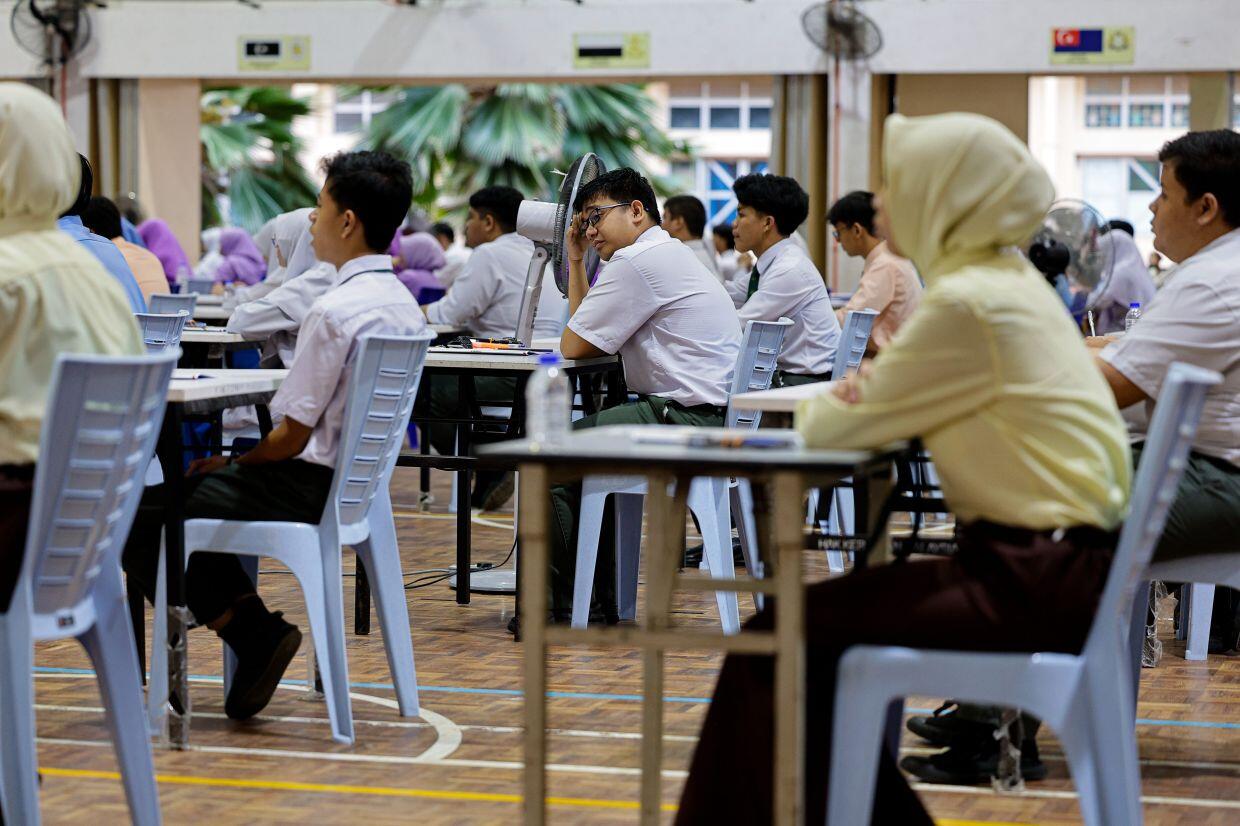Wondering what is the SPM Malay format? Feeling lost and struggling to understand how SPM Bahasa Melayu is structured? Not sure how to meet examiners' expectations? You’re not alone.
The Sijil Pelajaran Malaysia SPM examination underwent a major format change in 2021, and the Ministry of Education Malaysia came up with a new format that is applicable to all subjects, including Malay. Yet, some Malaysian high school candidates may find themselves asking these questions: What is the new format? What exactly do I need to know? How do I prepare for it?
If that sounds like you, you’re in the right place.
In this guide, we’re going to walk you through each section of the paper, explain common mistakes candidates make, highlight the key expectations from examiners, and share practical tips to help you get the results you’re aiming for.
Knowing the format isn’t just about memorising the sections—it’s about understanding the examiner's expectations and how to write your answers to meet the requirements.
Ready to get started? Let’s go!

What is the Sijil Pelajaran Malaysia Malay format at a glance:
1. Overview: What is the SPM Malay Format?
2. Bahasa Melayu Kertas 1: Article essay SPM (Karangan)
3. Bahasa Melayu Kertas 2: Reading & Comprehension (Pemahaman)
4. Bahasa Melayu Kertas 3: Speaking Test (Ujian Mendengar)
5. Bahasa Melayu Kertas 4: Speaking Test (Ujian Mendengar)
6. Master your summary writing skills with the right tutor!
Overview: What is the SPM Malay Format?
Now, let’s take a look at the format for the SPM Bahasa Melayu paper. There are four papers that you have to complete in the exam. You’ll find them listed in the table below:
| Paper | Components | Duration | Marks | Skills Tested | Weightage |
|---|---|---|---|---|---|
| Bahasa Melayu Kertas 1 (1103/1) | Essay Writing (Kemahiran Menulis/ Karangan) | 2 hours | Section A: 30 marks Section B: 70 marks | Writing skills, grammar accuracy, vocabulary, coherence, and creativity in text | 100 |
| Bahasa Melayu Kertas 2 (1103/2) | Comprehension, Grammar, and Literature (Kemahiran Membaca) | 2 hours 30 minutes | Section A: 35 marks Section B: 35 marks Section C: 30 marks | Summary writing, comprehension, identifying keywords, and literary awareness | 100 |
| Bahasa Melayu Kertas 3 (1103/3) | Oral Examination (Kemahiran Bertutur) | 3-5 minutes (individual) 12-15 minutes (group) | Section A: 40 marks Section B: 30 marks | Verbal fluency, pronunciation, articulation, grammar, and group interaction skills | 70 |
| Bahasa Melayu Kertas 4 (1103/4) | Listening Test (Kemahiran Mendengar) | 30 minutes | 30 marks | Listening comprehension, note-taking, understanding, the main idea, and specific details. | 30 |
This is an overview table to give you an idea of the contents of each paper, the skills tested and their weightage. We will look into each one of these papers in detail. Read on to find out more about all the papers!

1. Bahasa Melayu Kertas 1: Article essay SPM (Karangan)
The Kertas 1 BM SPM is split into two sections - Bahagian A and Bahagian B.
In Bahagian A, students are presented with a single question, created based on a combination of various stimulus-guided materials (bahan rangsangan). As an example, the student may be asked to write a resume for a job he or she is interested in, but must consider only the three job advertisements in the question. Since Bahagian A is a limited-response subjective question, students only need to write 150 to 200 words.
On the other hand, Bahagian B comprises 4 questions; however, students only need to answer just one. These 4 questions come with their respective domains, such as career, personal, education and public. These are divided into two categories: soalan berformat and soalan tidak berformat.
Additionally, this is an open-response, subjective question; students are expected to write longer essays, based on the short excerpts, to give students a better idea of what to include in their essay. The word limit for this section is from 350 to 500.
Kertas 1 tests on how well students can apply, analyse, evaluate and create ideas through writing by assessing their ability to generate ideas, creatively apply the language, demonstrate an appreciation for the language, and use proper discourse markers (penanda wacana).
Overall, secondary school students have 2 hours to complete this paper, which contributes 100 marks to the overall score of the SPM Malay paper 1.
Tips to Ace this paper
Bahagian A: Karangan berdasarkan bahan rangsangan (30markah)
1. Understand the stimulus thoroughly
- Identify the question's focus by reading it carefully and looking for keywords and themes.
- Analyse all visual materials given, such as images, excerpts, or statements.
- Describe each element/word shown and relate it to the question.
2. Answer accurately
- Avoid going off-topic. Always connect your content to the stimulus.
- Present clear reasoning to explain how the stimulus supports your ideas.
3. Structure your answer
- Write your karangan within the 200-word limit. Avoid exceeding.
- Follow a simple structure like:
- Intro/Pengenalan: Introduce the stimulus theme. You can include an attention-grabbing element, such as a fact/statistic. Limit: ~40 words.
- Body/Isi: Include 2-3 points with explanations that support or justify your main points. Provide relevant examples. Use interesting expressions (ungkapan menarik) like simpulan bahasa, peribahasa and others. Limit: ~60-80 words.
- Conclusion/Penutup: Wrap up with a summary. Provide a recommendation or hope related to the topic. Limit: ~30-40 words.
4. Reread your essay:
- Check for grammar, spelling and sentence structure.
- Count the words for one last time to ensure it’s within the word limit.
Bahagian B: Karangan Umum (70 marks)
1. Analyse the essay questions
- Understand the question and its requirements
- Identify which one you feel the most confident in answering
- Identify the theme and keywords in the question
- Scribble the relevant and strong points in the papers to help you decide.
2. Plan your essay
- Begin your planning once you have decided on the question
- Spend 5-10 minutes planning
- Brianstorm 3-4 main points
- Think of relevant examples and supporting arguments for each
- Observe if your points are flowing coherently
3. Follow a strong essay structure
- Introduction: Write an engaging opening that grabs the attention of the reader
- Body paragraphs: Each paragraph should focus on one main point, supported by relevant examples and explanations.
- Conclusion: A summary that wraps up your whole essay and leaves an impact or makes readers think.
4. Check again
- Once you have completed the essay, check for grammar, spelling, vocabulary, and any other details to ensure the karangan is good to go.
5. Practice regularly
- Read widely to enhance your vocabulary, gain inspiration, and find examples.
- Write regularly to improve your skills
6. Bonus tips for both sections:
- Manage your time wisely and avoid spending too much time deciding on a topic. Go with the one that you feel the most confident in.
- Avoid leaving questions unanswered. Do your best to respond to each one.
- Avoid exceeding the word limit. Always stick to the instructions.
Do you feel like you need more help with this essay writing? Don’t worry, we've got you covered! Find out more about SPM Malay essay writing to master!


2. Bahasa Melayu Kertas 2: Reading & Comprehension (Pemahaman)
Now, let’s move on to the next paper. Kertas 2 BM SPM is divided into three sections - Bahagian A, Bahagian B, and Bahagian C, where students’ reading skills are tested via limited-response and open-response questions.
Although Kertas 2 (1103/2) is also a written examination like Bahasa Melayu Kertas 1, this paper focuses on the ability of students to read and understand the language. The goal of this paper is to test whether students can accurately identify information, state the meanings of words, interpret and reflect on texts, and make connections between these ideas.
Students are expected to demonstrate their level of understanding, application, analysis, evaluation and creativity in this paper. Let’s dive into each section!
Bahagian A (sistem dan aplikasi bahasa) highlights systems and applications of the Malay language in these 5 areas or question categories: morphology (morfologi), syntax (sintaksis), editing (penyuntingan), use of classic and standard Malay (bahan teks klasik dan Bahasa Melayu Moden), and proverbs (peribahasa). After analysing and interpreting texts in Bahagian A, students will list out the meanings of words, replace words or sentences, create new sentences or identify errors in the texts.
For Bahagian B (Pemahaman), students have to answer 3 comprehension questions related to Form 4 and Form 5 literature, including the traditional poems, short stories, dramas and novels they have already learnt.
Lastly, for Bahagian C (Rumusan), it is constructed based on one short essay and another stimulus (such as a poster or poem). Students are to write a summary, in less than 120 words, following these two items. The Kertas 2 Bahasa Melayu SPM lasts 2 hours and 30 minutes - would you like to know the complete marking scheme for all the SPM Malay papers?
Smart Tips to Master the Second Component in the Exam
Bahagian A: Sistem & aplikasi bahasa
- Mastering Malay grammar
To do well in this section, you need a strong grasp of Malay grammar rules, including types of words, proper usage, and sentence structure. Here’s how you can prepare:
- Practice forming sentences using kata adjektif, majmuk, kata ganda, peribahasa, and other elements.
- Memorise common peribahasa and their meanings.
- Familiarise yourself with the question structure, such as:
- Isi tempat kosong
- Kenal pasti subjek & predikat
- Bina ayat tanya
- Tukarkan ayat besusunan biasa kepada ayat bersusunan songsang
- Senaraikan kata majmuk, dan adjektif dan bina ayat snediri daripada setiap perkataan yang dipilih.
- Senaraikan kesalahan bahasa dan betulkan kesalahan-keslahan itu.
- Senaraikan peribahasa yang sesuai/ berikan peribahasa yang hampir sama maksud
Unfortunately, there’s no shortcut to get around this. You need to practice a lot to expose yourself to different structures and challenges in these categories: Morfologi, Sintaksis, Penyuntingan, Bahasa Melayu standard, and Peribahasa.
Consistent practice is the key!
Bahagian B: Pemahaman
1. Read actively
Newspaper clips, articles, or blogs — read extensively to equip yourself with the knowledge of a variety of topics.
2. Practice critical and reflective thinking
Don’t just accept the material at face value — question the ideas, structure, and language used. Ask yourself:
- Does the argument make sense?
- Is the writing effective and logical?
- How does it relate to your own experiences or knowledge?
- Which parts could be improved?
- Your opinion about the theme/issue?
By doing this regularly, you’ll sharpen your ability to think critically, reflect deeply, and express more thoughtful responses.
3. Familiarise yourself with Komsas
This is a no-brainer. In order to do well in this section, you need to know your Komsas inside out. Understand the themes, plot, character development, moral values, and other important features.
4. Use evidence to support your answers
Use supporting texts, whether it’s a point or a quote from the passage.
5. Answer in complete sentences
Avoid writing your answers in point form unless the question specifically mentions it.
6. Understand command words
Understand all the command words and the differences between them. This will help you write your answers better and avoid losing marks. For example:
- "Senaraikan" means to list the points only (no explanation needed).
- "Huraikan" means to explain the points in detail.
Misinterpreting these can lead to incomplete or incorrect answers, even if your content is good.
Bahagian C: Rumusan
1. Underline the isi from all the items given
Read all three bahan given and carefully understand the keywords in the texts to identify:
- Tema rumusan from all three bahan
- Fokus bahan (the specific focus or requirements, e.g. faedah, langkah, punca, kesan, etc.)
- Identify the isi-isi (from bahan 1-3) that are relevant to the focus that you have identified.
Then look at the bahan rangsanagan (stimulus text) or petikan and identify points that directly address the focus or requirements. Avoid summarising everything. Ensure the isi utama is aligned with the fokus soalan.
2. Use your own words
This is mentioned in the instructions. Pay attention to this and avoid copying the words from the petikan. Remember, language carries a total of 10 marks.
3. Rumusan outline (Rangaka rumusan)
Before writing, ensure that you have jotted down a rangka rumusan to organise your points and thoughts. Your rangka rumusan should have:
- Pendahuluan: A general sentence introducing the theme and focus of the rumusan.
Example formula: Rumusan membincangkan + fokus pertama + fokus kedua + fokus ketiga.
- Isi-isi: You need a total of 8 isi for this section.
Example:
- Fokus 1: Punca pencemaran - 6 isi
- Fokus 2: Kesan pencemaran - 1 isi
- Fokus 3: Langkah mengatasi - 1 isii
The distribution of the 3 fokus is up to you to decide.
Penutup: Wraps up the whole rumusan with this formula: cadangan + tema + harapan/kesan.
Example: Langkah-langkah tersebut wajar diambil agar alam sekitar sentiasa terpelihara demi kesejahteraan generasi akan datang.

3. Bahasa Melayu Kertas 3: Speaking Test (Ujian Mendengar)
The third paper for SPM Bahasa Melayu is a speaking test. This paper tests the secondary school students’ ability to understand, apply, analyse and evaluate their ability to speak the Malay language. Several aspects in Bahasa Melayu speaking skills are considered in Kertas 3 (1103/3), which incorporates grammar and vocabulary; pronunciation, intonation and tone; fluency and mannerism; as well as ideas and meanings of words.
The two sections of the paper are Bahagian A (40 marks) and Bahagian B (30 marks); however, the format of answering these questions is far different from the written assessments. Students' speaking skills are tested both individually and in groups.
Bahagian A looks at individual speaking abilities. Students are presented with a short paragraph in Bahagian A, along with another stimulus (often in the form of pictures) - speaking skills are evaluated via Q & A with your examiner.
Bahagian B is a group speaking test in the form of a discussion. Students are put into groups of 3 to 5 people and are presented with a theme or topic to discuss, such as patriotism and citizenship, or even sports and recreation. The theme is structured in a single paragraph, allowing candidates the flexibility to interpret the question in their own way.
Whether candidates can choose their own group members depends on the school and the examiner’s discretion — you might get to form your own group, or the examiner assigns a group. Either way, it’s advisable to be prepared for both situations and avoid having high expectations that you get to select your groupmates.
For the time allocation, the individual speaking test is expected to last around just 3 to 5 minutes, while the group speaking test is slightly longer at 12 to 15 minutes.
You can also check out everything you need to know about SPM Malay 2025.
Key Tips for Success in SPM Malay Kertas 3
- Speak clearly and confidently
Your voice should be loud and clear. Avoid mumbling or speaking too softly.
- Speak standard Malay:
Avoid using regional dialects like Kelantan and Terengganu dialects. Also, for Chinese and Indian candidates, avoid speaking Malay with Chinese or Tamil accents. Practice standard Malay pronunciation.
- Avoid using slang or informal words
Use formal language suitable for academic speaking. Avoid abbreviations, informal words, or slang, or mixing up English words.
- Practice speaking spontaneously
Avoid memorising points and instead practice thinking and speaking on the spot. This will help you to expand on your points effortlessly.
- Think before speaking
Take a few moments to think before speaking. Don’t rush into answering immediately.
Taking time to refine your thoughts is much better than rambling with no intention.
- If you get stuck, pause briefly
Take a deep breath when you get stuck. This happens, and it’s okay to take a few seconds to gather your thoughts. Avoid going into panic mode, stay calm and assure yourself that you’ve got it.
- Use complete sentences (ayat lengkap)
Avoid one-word or overly casual answers. Speak in proper and complete sentences.
- Use penanda wacana
These make your speech sound better and flow smoothly. For example:
Pertama sekali, selain itu, kesimpulanya, and others.
- Use peribahasa and/or simpulan bahasa
Memorise at least 5 popular peribahasa, or simpulan bahasa, relevant to common topics, and know how to use them naturally in sentences.
- Fluency matters
Ensure your speech is fluent, work on the pronunciation and how you structure the sentences.
- Use appropriate tone and facial expressions
Make eye contact, project your voice, and avoid filler words like “aa…,” “umm…,” or “errr.” If you make a small mistake, don’t panic, apologise and keep going. Confidence matters more than being perfect.
Additional Tips for Group Discussion
1. Balance your talk time
Don’t be greedy for speaking time in group discussions. In a group of five, you’ll be given around three minutes each to share your points, adding up to a total of 15 minutes for the whole section. Avoid talking too much and dominating the session; the examiner may deduct marks for a poor attitude.
2. Help each other out in group discussions
Know the main points or keywords for every candidate in your group. This will be helpful when a group member gets stuck and doesn’t know what to say; someone else in the group should help by quietly prompting them with the keywords.
3. Engage in the discussion politely and naturally
Build on others’ points, agree or disagree respectfully, and avoid interrupting unnecessarily.
4. Bahasa Melayu Kertas 4: Speaking Test
Finally, the last paper for SPM Bahasa Melayu kertas 4 (1103/4) is the speaking test. This paper tests whether the candidates can exhibit their potential to understand, apply and analyse Bahasa Melayu via listening skills. Being a listening skills paper, focuses on Malay language skills and the application of audible information, and tests students' ability to provide accurate answers based on the audio being heard.
Form 5 candidates are assessed in the form of objective questions and limited-response subjective questions. In simpler terms, students have to listen to excerpts being played out (such as those from short stories or speeches) and, based on what was heard, provide answers to the written questions in the paper.
To illustrate, candidates are given one minute to listen to an excerpt and then given 30 seconds to answer about 5 questions related to the excerpt.
After those 30 seconds, candidate are given another minute to listen to the same excerpt, and a final 30 seconds to write and double-check their answers. The process is repeated for a total of 4 to 6 excerpts in the paper, which make up roughly 20 to 25 questions for the candidate to answer. As a whole, Kertas 4 takes up about 30 minutes to complete, while contributing a score of 30 marks.

Your Guide to Doing Well in Kertas 4
1. Read the questions before the audio starts
Start reading through the materials and guess the content. This helps you listen with purpose and know the specific information to look for when the audio plays.
2. Underline the keywords in the question
Focus on important words like tarikh, tempat, tujuan, perasaan, etc.
3. Predict the answer before listening to the audio
Sometimes, you can guess the likely answer based on logic, then listen to confirm or reject it. This helps sharpen your focus when listening to the audio.
3. Listen actively
Don’t just listen, pay attention to tone, intentions, and emotions in the speaker’s voice. Sometimes the answer lies in how something is said.
4. Don’t panic, stay calm
Don’t panic when you miss a part. The audio will be played again, and you can still catch up. Answer all the other questions. Avoid wasting time worrying.
5. Take down notes
Avoid answering in full sentences immediately, as this might distract you from listening to the rest of the audio intently. Instead, take active notes throughout, and start answering when you are given the time.
6. Stay in sync with the pace
Avoid rushing to answer before the speaker finishes. But also, don’t write your points too late as well — you might forget the ideas shared in the audio earlier.
7. Don’t overthink your answers
Trust your instincts. Don’t spend too much time deciding on the answer you have in mind. Avoid leaving any questions blank.
9. Practice… a lot
Again, there’s no shot cut to this. You need to practice to sharpen your listening skills. Here are some effective ways to do that:
- Practice like in the real exam
Make sure to practice under a real exam setting. Which means, no pausing, no repeating more than 2 times, and no checking answers in between. The more realistic your practice is, the better you will perform during your actual exam. - Purchase a Paper 4 exercise book that comes with an audio CD
Play the audio on your laptop or computer, and answer the questions as you listen, just like in the real exam. - Find free resources or past year papers
While many past-year papers don’t include audio files, you can still make use of them. Record yourself reading the text aloud on your phone (or anyone in the family), then play it back while attempting the exercises. Another way to do this is by requesting a family member or a friend to read the text out loud and record it. You can save this file on your laptop or computer and play it back whenever you’re answering the exercises. - Practice like in the real exam
Make sure to practice under a real exam setting. Which means, no pausing, no repeating more than 2 times, and no checking answers in between. The more realistic your practice is, the better you will perform during your actual exam.
How about some practice with the only SPM Malay papers you'll need to succeed in Bahasa Melayu?

5. Master your summary writing skills with the right tutor!
Do you want to learn how to write a good essay in Bahasa Melayu following the format SPM by the Lembaga Peperiksaan Malaysia? Improve your verbal communication skills in Malay? Be a whiz at both writing and reading in the language? Be it SPM English, SPM Science or SPM Malay, Superprof brings you the tutors to help build the writing, reading, speaking and listening skills you'll need to succeed in Bahasa Melayu!
"How do I select my tutor?" Visit our Superprof Private Tutors page (you can find it on this page, too!) and key in "SPM Bahasa Melayu" into our search engine. You might also notice the options "Around Me" and "Online" - that's because Superprof is offering you the choice of face-to-face or online lessons! With tutoring rates as low as RM5 for lessons in SPM Malay, you can easily hop on the ride to mastering Bahasa Melayu - even from the comfort of home.
Are there certain requirements you are looking for in a Malay online tutor? Our page directs you to each tutor's profile the moment you click on it - read about the tutor's teaching methodology, tutoring experience, lesson rates and even student reviews. You can even experience your first lesson for free when you sign up with Superprof!
Joining a class for SPM Bahasa Melayu is no longer a hassle for secondary school students - quality Malay education is just a few clicks away!
Discover a Malay language course for foreigners on Superprof!
Résumer avec l'IA :
















